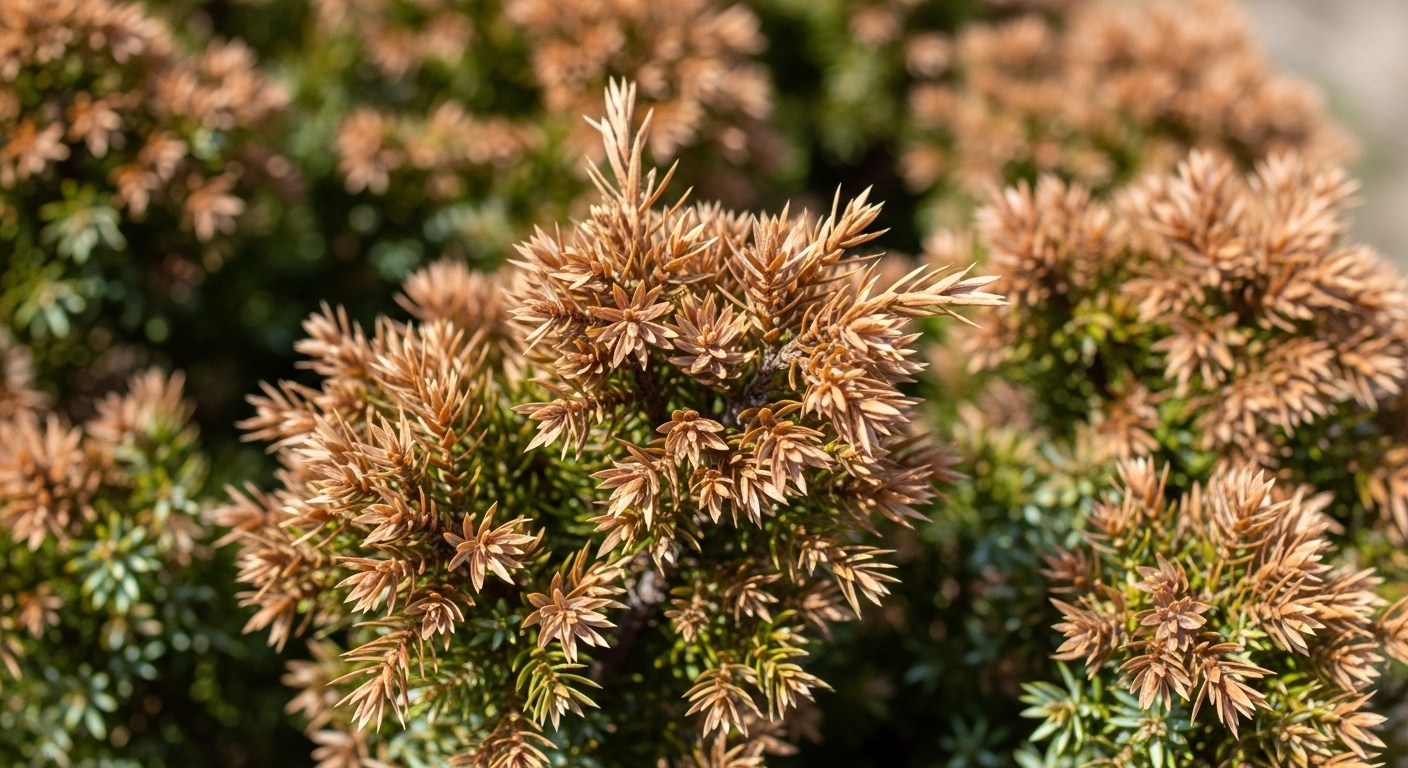Why Junipers Turn Brown (And How to Fix It)
We often see this at the nursery, and most cases are fixable once you match the symptom to its cause. Use the checklist below, starting with the most common issues.
1. Fungal Tip Blights (Phomopsis, Kabatina)

Tell-tales:
Browning begins at the tips and creeps inward; tiny gray bands or black fruiting specks on dead tips.
Why it happens:
Cool, wet springs; dense growth with poor air flow.
Do this now:
- Prune 6–8" behind visibly infected tissue; bag and trash clippings.
- Sanitize tools between cuts (70% alcohol).
- Improve airflow: light thinning, avoid overhead watering in the evening.
- If confirmed/recurrent: use a juniper-safe fungicide labeled for tip blights; follow the label exactly.
Pros:
Pruning + airflow often stops the spread quickly.
Cons:
Severe infections may require multiple fungicide rotations.
2. Root Rot/Waterlogging (often Phytophthora)
Tell-tales:
Sudden browning of entire twigs/sections; pot feels heavy; roots dark, mushy, or sour-smelling.
Why it happens:
Overwatering, compacted or poorly draining soil, planting too deep.
Do this now:
- Let the soil dry to the touch between waterings. Water deeply, then drain it thoroughly.
- Ensure the pot or site drains freely; elevate pots slightly off saucers/trays.
- In severe cases, repot into a well-draining mix; trim only dead roots.
- Consider a root-rot labeled product if disease is confirmed.
Pros:
Fixing drainage often restores vigor fast.
Cons:
Advanced root rot is difficult to reverse; avoid aggressive root work.
3. Water Stress (too dry or too wet)
Tell-tales:
Crispy browning from drought; dull, limp foliage from overwatering.
Right rhythm:
Water when the top ½–1 inch of soil is dry; then soak thoroughly.
Do this now:
Calibrate by lifting the pot—learn the "light vs. heavy" feel—and adjust the frequency seasonally.
Pros:
Simple habit change.
Cons:
Inconsistent routines (vacations, heat waves) can undo progress.
4. Salt and Chemical Injury
Tell-tales:
Browning on road/sidewalk sides; tip burn after winter or after pet urine spots.
Do this now:
Flush soil with plenty of water; use burlap or barriers next winter; redirect pets.
Pros:
Often cosmetic; new growth hides damage.
Cons:
Repeated exposure can kill fine roots and branchlets.
5. Insect Pests (Spider Mites, Scale)
Spider mites:
Fine webbing, dusty stippling, worse in hot/dry sites. Confirm with a white paper tap-test (tiny moving dots).
Scale:
Bumps on stems/needles; sticky honeydew and sooty mold may appear.
Do this now:
- For mites: use a strong water rinse, followed by insecticidal soap or horticultural oil; repeat as directed.
- For scale: dormant-season oil and/or properly timed systemic insecticides; follow label directions.
- Improve vigor (light, airflow, watering rhythm).
Pros:
Early catches are easy to control.
Cons:
Heavy scale requires treatments timed to crawler stages.
6. Planting Depth, Physical Damage, and Rodents
Tell-tales:
Trunk flare buried; girdling from chewing; browning after recent transplant.
Do this now:
Replant so the root flare is at soil level; protect the base with guards; keep newly moved trees stable.
Pros:
Correcting depth is a one-time fix.
Cons:
Girdling damage may not recover beyond the chewed point.
7. Weather Stress (Scorch, Winter Burn)

Tell-tales:
South/west-facing sides bronze/brown; post-winter browning with evergreen desiccation.
Do this now:
Provide windbreaks, winter burlap screens, and water well until the ground freezes.
Pros:
Preventable with simple shielding and fall watering.
Cons:
Damage often becomes apparent weeks later.
8. Natural Aging/Shedding
Tell-tales:
Interior needles brown and drop; outer tips stay green.
Do this now:
Gently comb out dead interior foliage; light thinning to improve light penetration.
Pros:
Completely normal; great time to tidy structure.
Cons:
Easy to over-prune—keep removal light.
When to Worry
Act quickly if you see these signs:
- Browning is widespread or accelerating
- You see mushy roots, strong sour odor, or cankers/ooze
- Entire branches are dying back
That's the time to act quickly with pruning, drainage fixes, and—if confirmed—targeted treatments.
Your Action Plan (Step-by-Step)
- Map the pattern: Tips, interior, and whole sections. Photograph today for comparison.
- Check moisture & drainage: Adjust watering, ensure free drainage, and elevate pots.
- Inspect closely: Look for webbing, specks, sticky residue, bands/cankers. Do the paper tap-test.
- Prune & sanitize: Remove dead/diseased growth; disinfect tools.
- Enhance airflow and light: Opt for open, well-lit interiors.
- Protect from salts/chemicals: Flush soil; add seasonal barriers.
- Targeted treatment (if confirmed):
- Fungi: Juniper-safe fungicide labeled for tip blights.
- Mites/scale: Use horticultural oil/soap, following the label.
- Monitor 3–4 weeks: Look for fresh green tips and halted spread.
Good to Know
- Junipers don't like wet feet. When in doubt, prioritize drainage over frequency.
- Most browning caught early is reversible with cultural fixes alone.
- Seasonal bronzing can look scary; new spring growth often masks cosmetic damage.
- For more care resources and supplies, you can explore options for juniper bonsai.
